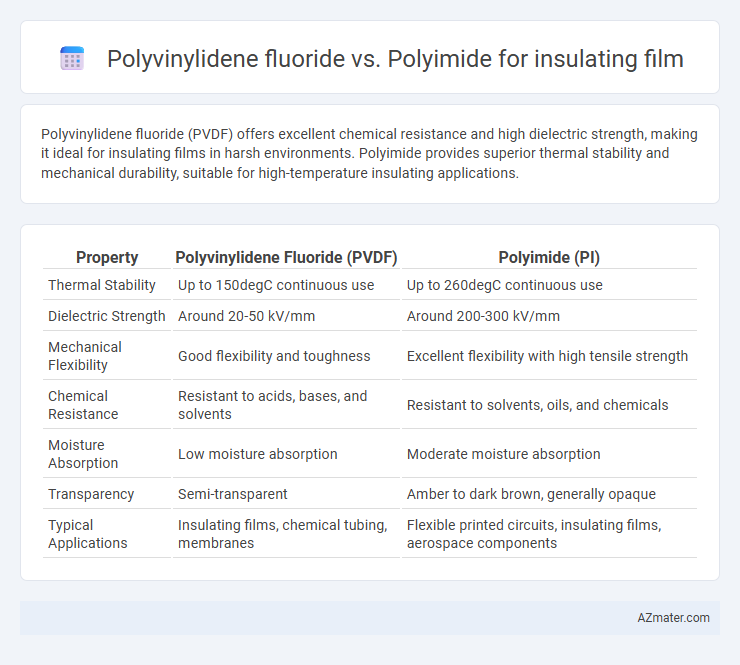Polyvinylidene fluoride (PVDF) offers excellent chemical resistance and high dielectric strength, making it ideal for insulating films in harsh environments. Polyimide provides superior thermal stability and mechanical durability, suitable for high-temperature insulating applications.
Table of Comparison
| Property | Polyvinylidene Fluoride (PVDF) | Polyimide (PI) |
|---|---|---|
| Thermal Stability | Up to 150degC continuous use | Up to 260degC continuous use |
| Dielectric Strength | Around 20-50 kV/mm | Around 200-300 kV/mm |
| Mechanical Flexibility | Good flexibility and toughness | Excellent flexibility with high tensile strength |
| Chemical Resistance | Resistant to acids, bases, and solvents | Resistant to solvents, oils, and chemicals |
| Moisture Absorption | Low moisture absorption | Moderate moisture absorption |
| Transparency | Semi-transparent | Amber to dark brown, generally opaque |
| Typical Applications | Insulating films, chemical tubing, membranes | Flexible printed circuits, insulating films, aerospace components |
Overview of Polyvinylidene Fluoride (PVDF) and Polyimide
Polyvinylidene fluoride (PVDF) is a fluoropolymer known for its excellent chemical resistance, high dielectric strength, and thermal stability up to 150degC, making it ideal for insulating film applications in harsh environments. Polyimide, on the other hand, exhibits superior thermal resistance up to 400degC, exceptional mechanical properties, and excellent electrical insulation, which suits high-temperature electronic and aerospace uses. Both materials offer unique benefits: PVDF provides chemical durability and UV resistance, while polyimide excels in high-temperature endurance and mechanical robustness.
Chemical Structure and Composition
Polyvinylidene fluoride (PVDF) is a semi-crystalline fluoropolymer composed of repeating -(CH2-CF2)- units, offering strong carbon-fluorine bonds that provide excellent chemical resistance and dielectric properties. Polyimide consists of imide linkages formed by the reaction of dianhydrides and diamines, resulting in an aromatic heterocyclic polymer with superior thermal stability and mechanical strength. The chemical composition of PVDF emphasizes fluorine-rich chains for chemical inertness, while polyimide's aromatic backbone and imide groups contribute to its high-temperature performance and exceptional insulating capabilities.
Thermal Stability Comparison
Polyvinylidene fluoride (PVDF) exhibits excellent thermal stability with a melting point around 177degC and continuous use temperature up to 150degC, making it suitable for moderate heat applications. Polyimide film withstands significantly higher temperatures, maintaining structural integrity at continuous use temperatures above 260degC and decomposition temperatures exceeding 500degC, ideal for high-temperature environments. The superior thermal resistance of polyimide ensures better performance in demanding insulation applications compared to PVDF.
Electrical Insulation Properties
Polyvinylidene fluoride (PVDF) exhibits excellent electrical insulation properties with a high dielectric strength typically around 20-30 kV/mm, making it suitable for applications requiring robust electrical resistance and stability. Polyimide films offer superior thermal stability and maintain consistent insulation performance at high temperatures, with dielectric strengths often exceeding 200 kV/mm, which is advantageous in demanding electronic environments. While PVDF provides better chemical resistance and flexibility, polyimide is preferred in high-temperature and high-voltage insulation applications due to its exceptional dielectric performance and thermal endurance.
Mechanical Strength and Flexibility
Polyvinylidene fluoride (PVDF) exhibits excellent mechanical strength with high tensile strength and good flexibility, making it suitable for demanding insulation applications that require durability and resilience. Polyimide films offer superior thermal stability and exceptional mechanical strength, maintaining flexibility even at elevated temperatures, which is critical for advanced electronics and aerospace insulation. When balancing mechanical strength and flexibility, PVDF provides a more flexible option for general use, while polyimide excels in environments with high thermal and mechanical stress.
Chemical and Environmental Resistance
Polyvinylidene fluoride (PVDF) exhibits outstanding chemical resistance against acids, bases, and solvents, making it highly durable in aggressive chemical environments. Polyimide films offer superior thermal stability and excellent resistance to radiation and solvents but can be vulnerable to hydrolysis under prolonged exposure to moisture. PVDF's superior weathering resistance and low moisture absorption rate make it more suitable for outdoor and humid conditions compared to polyimide.
Application Areas in Industry
Polyvinylidene fluoride (PVDF) excels in chemical resistance and weatherability, making it ideal for insulating films in the chemical processing, electrical, and photovoltaic industries. Polyimide films offer superior thermal stability and mechanical strength, widely used in aerospace, electronics, and automotive sectors requiring high-temperature insulation. Both materials serve critical roles in flexible printed circuits, but PVDF is preferred for moisture-sensitive environments while polyimide dominates in environments with extreme thermal demands.
Manufacturing Processes and Cost
Polyvinylidene fluoride (PVDF) insulating films offer easier manufacturing processes characterized by solution casting and extrusion techniques, leading to lower production costs compared to polyimide films. Polyimide films require complex imidization reactions and precise thermal curing, resulting in higher energy consumption and more expensive equipment. Consequently, PVDF is favored in cost-sensitive applications, while polyimide's superior thermal stability justifies its premium price in high-performance insulation needs.
Lifespan and Reliability Analysis
Polyvinylidene fluoride (PVDF) offers excellent chemical resistance and UV stability, contributing to a lifespan of over 20 years in harsh environments, making it highly reliable for long-term insulating film applications. Polyimide films exhibit exceptional thermal stability, maintaining electrical insulation properties at temperatures up to 400degC, which ensures superior reliability in high-temperature conditions but may degrade faster under prolonged UV exposure. For lifespan and reliability, PVDF's durability in outdoor and chemically aggressive environments contrasts with polyimide's strength in extreme heat, guiding material selection based on specific operating conditions.
Summary: Choosing the Right Insulating Film
Polyvinylidene fluoride (PVDF) offers excellent chemical resistance, high dielectric strength, and thermal stability up to 150degC, making it ideal for insulation in harsh environments. Polyimide films provide superior thermal endurance, maintaining integrity at temperatures above 200degC, along with excellent mechanical properties and electrical insulation. Selecting the right insulating film depends on operating temperature, chemical exposure, and mechanical stress requirements, with PVDF favored for chemical resistance and Polyimide preferred for high-temperature applications.

Infographic: Polyvinylidene fluoride vs Polyimide for Insulating film
 azmater.com
azmater.com